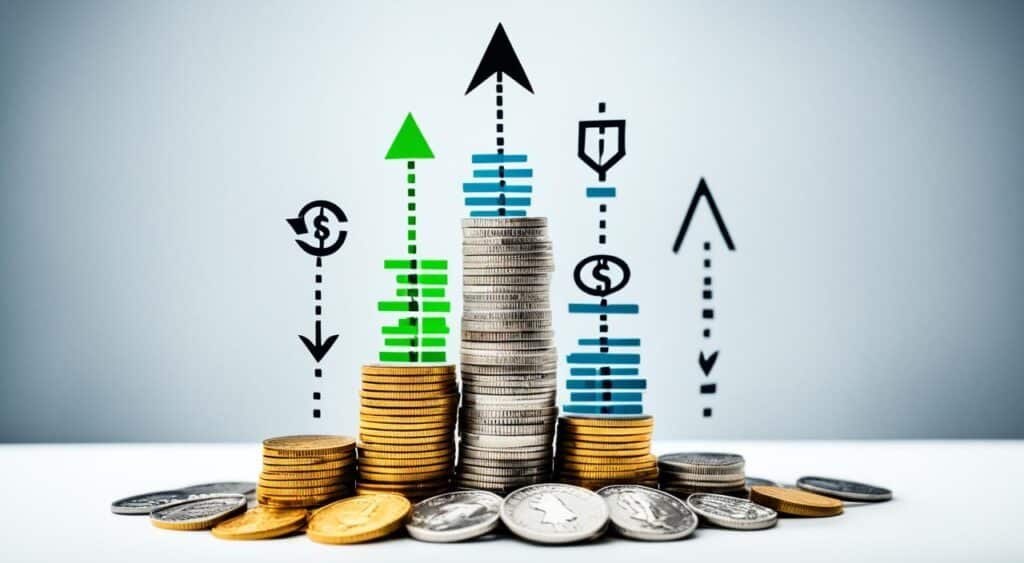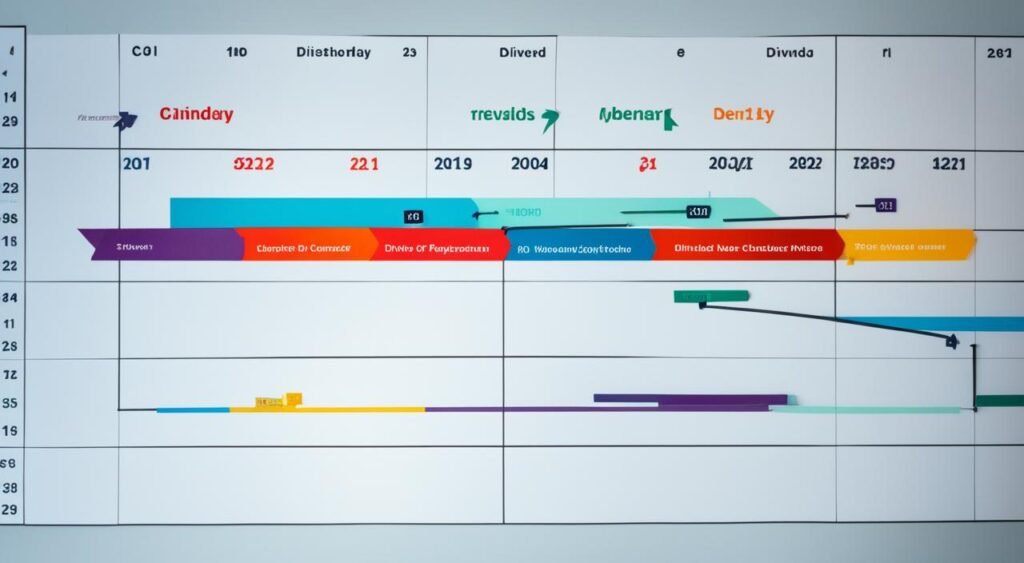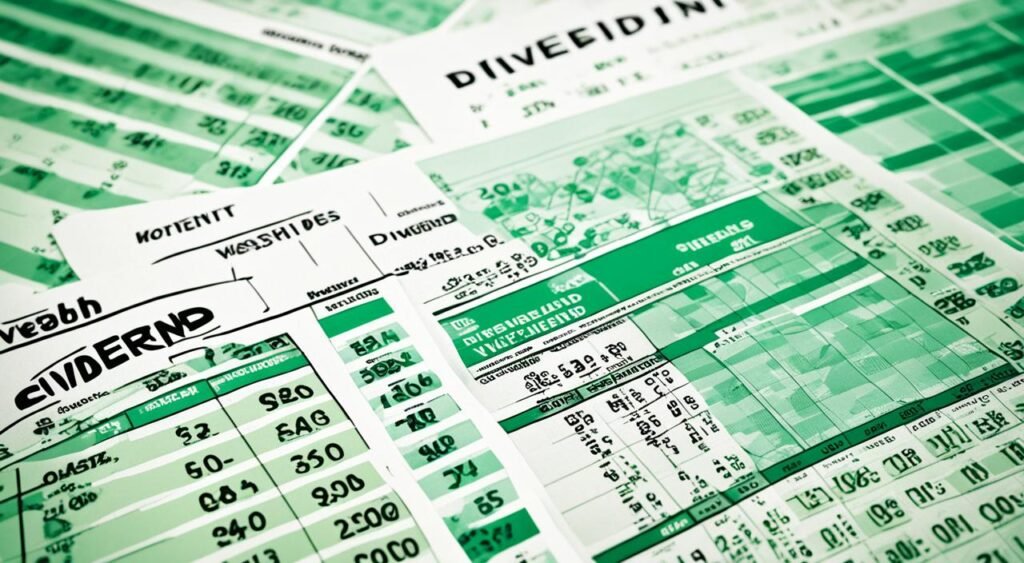Table of Contents
ToggleCompanies that are listed on stock exchanges pay dividends to their shareholders. These payments come from the company’s profits. They can be cash or more shares, known as stock dividends. Companies pay dividends to keep investors interested and to show they are doing well financially.
For many investors, dividends are key. They offer a steady income and can help protect against market drops.
Key Takeaways
- Dividends are payments made by publicly traded companies to their shareholders, representing a portion of the company’s profits.
- Dividends can be paid in cash or in the form of additional shares, known as stock dividends.
- Companies pay dividends to attract and retain investors, signaling financial stability and consistent growth.
- Dividends can provide investors with a reliable stream of income and potentially buffer against market downturns.
- Investors can invest in dividend-paying stocks, mutual funds, or ETFs to gain exposure to dividends.
Understanding Dividends
Dividends are key in the stock market. They are a part of a company’s profits shared with its shareholders. These payments can be in cash or more shares, known as stock dividends.
Companies pay dividends to draw in and keep investors. It shows the company is doing well and growing steadily. For investors, dividend stocks offer a steady income and the chance for the stock price to go up. Dividends can also protect investors during market drops, making their investments safer.
Also Read: What Specializations Are Available In A Bachelor Of Education Program?
Dividends and Shareholder Value
Companies give out dividends to make shareholders’ value go up and show they care about giving back to investors. These payments usually happen every three months. The company’s board decides how much and when to pay them.
- Dividends give investors a steady income, especially if they want a safe investment.
- Stocks that pay dividends might also grow in value. Investors like these companies because they seem stable and likely to grow.
- Dividends play a big part in how a company is valued. They show the company is doing well financially and its leaders believe in its future.
When looking at dividend-paying stocks, it’s key to check the dividend yield, payout ratio, and how often the dividend is paid. Knowing about dividends helps investors make better choices and build a strong investment portfolio.
Also Read: What Is Auto Insurance and What Does It Cover?
Types of Dividends

Publicly traded companies often give back to their shareholders in two main ways: cash dividends and stock dividends. These methods have their own benefits and things to think about for investors.
Also Read: Essential Guide To Insurance Of Vehicle: Coverage And Costs
Cash Dividends
Cash dividends are the most common type. Here, the company gives a part of its profits to shareholders as cash. The cash dividend amount is usually given in cents per share. The company will also share the payment date.
Stock Dividends
Some companies might give out shares of their own stock instead of cash. This is called a stock dividend. Shareholders get new shares based on how many they already own. Stock dividends let shareholders own more of the company without spending more money.
Also Read: How To Maintain Strong Creditworthiness Over Time?
| Cash Dividends | Stock Dividends |
|---|---|
| Paid out in cash | Paid out in additional shares of the company’s stock |
| Provide shareholders with a direct cash payment | Increase shareholders’ ownership stake in the company |
| Typically expressed in cents per share | Expressed as a ratio or percentage of existing shares |
| Can be used by investors for income or reinvestment | May result in a lower stock price per share |
Cash dividends and stock dividends let companies share their profits with shareholders. This gives investors a chance to make money beyond just seeing the stock price go up.
Also Read: How Can You Improve Your Learning Skills?
Dividend

Dividends are key in finance, letting companies share profits with their shareholders. The company’s board decides how much and how often to pay dividends. They look at earnings, cash flow, and plans for the future.
Companies usually pay dividends in cash or stock. Cash dividends give shareholders a certain amount per share, often every quarter. Stock dividends give more shares to shareholders instead of cash.
Dividends offer a steady income for shareholders. They show a company is stable and growing. When a company says it’s paying a recently declared dividend, it can boost the share price. This shows the company can make profits and share them with its shareholders.
The dividend amount is in cents per share. Shareholders get the total payment by multiplying the dividend per share by their shares. Some companies offer special dividends or preferred stock with different types of dividends for their shareholders.
Dividends are a great source of income for investors. They’re key for those building a portfolio with dividend-paying stocks. Knowing about dividends helps investors make better choices when getting the dividend and investing in the company.
Dividend Payment Dates

Dividends have several important dates that investors should know. These dates tell when a shareholder will get their dividend from a company’s stock.
Declaration Date
The declaration date marks when a company says they will pay a dividend. This is the first step in the process. It tells shareholders a dividend is coming.
Ex-Dividend Date
The ex-dividend date is the last day to buy a stock and get the next dividend. If you buy after this date, the previous owner gets the dividend.
Record Date
The record date is when you must be on the company’s list to get the dividend. Only those listed on this date will get the dividend.
Payment Date
The payment date is when the dividend goes to eligible shareholders. This is when the dividends are put into accounts or sent as checks.
Knowing these dates is key for investors who want to make the most of dividend-paying stocks. By understanding when to buy and sell, investors can boost their dividend income.
The declaration date, ex-dividend date, record date, and payment date must be approved by the company’s board. This ensures dividends are given out fairly and on time to shareholders.
Measuring Dividends

Investors need to look at a few key metrics to understand dividends well. The dividend rate shows how much of a stock’s share price goes to dividends. It tells us how much cash a company gives back to its shareholders.
The dividend payout ratio shows what part of a company’s earnings go to dividends. This ratio helps investors see if a company is sharing enough profits with shareholders or keeping too much for growth.
| Metric | Description | Calculation |
|---|---|---|
| Dividend Yield | Percentage return based on the current stock price | Annual Dividend per Share / Current Stock Price |
| Dividend Payout Ratio | Percentage of earnings paid out as dividends | Dividends per Share / Earnings per Share |
| Dividend Growth Rate | Annualized growth rate of the dividend per share | (Current Dividend per Share – Prior Year Dividend per Share) / Prior Year Dividend per Share |
The dividend yield is found by dividing the annual dividend per share by the current share price. This gives a percentage that shows how profitable a stock is. It helps investors compare the dividend income of different stocks and see how good a company’s dividends are.
These metrics give a full view of a company’s dividend policies. They help investors make smart choices about dividend-paying stocks and their potential returns and risks.
Investing in Dividend Stocks

For those looking for steady income, dividend-paying stocks are a good choice. You can invest in these companies through individual stocks, mutual funds, or ETFs focused on dividends. This gives you different ways to earn income.
Diversifying with Dividend Investments
One way to invest is by picking individual dividend-paying stocks. These companies share their profits with shareholders as cash dividends. By spreading your money across various stocks, you can earn steady income and possibly see your investments grow.
Accessing Dividend Stocks through Funds
Another option is to use mutual funds or ETFs that focus on dividend stocks. These funds let you invest in many dividend-paying companies at once. They offer diversification and expert management, making it easier to invest in dividend stocks without picking each stock yourself.
To start investing in dividend stocks, opening a brokerage account is the first step. After setting up your account, you can begin building your dividend portfolio. This way, you can spread your income and possibly benefit from the growth of these companies.
| Investment Option | Advantages | Considerations |
|---|---|---|
| Individual Dividend Stocks |
|
|
| Dividend-Focused Mutual Funds and ETFs |
|
|
“Investing in dividend-paying stocks can provide investors with a reliable stream of passive income, while also offering the potential for capital appreciation.”
Dividend Taxation

Dividends are key to an investor’s portfolio, but knowing about taxes is vital. The tax on dividends depends on if they are ordinary or qualified.
Ordinary Dividends vs. Qualified Dividends
Cash dividends are usually taxed as ordinary income. This means they’re taxed like your regular income. On the other hand, qualified dividends get taxed at a lower rate, known as the capital gains rate.
To get the lower tax rate, a dividend must come from a U.S. or qualified foreign company. The investor must also have owned the stock for a certain time.
Reporting Dividend Income
Investors get a 1099-DIV form from their broker if they earn dividends in a year. This form shows how much they got and if it’s an ordinary or qualified dividend. They then report this on their taxes to figure out their tax.
Knowing how dividends are taxed is key for investors. It affects their returns from dividend stocks. By understanding the tax rules and reporting dividends right, investors can plan better and get more from their investments.
| Tax Treatment | Ordinary Dividends | Qualified Dividends |
|---|---|---|
| Tax Rate | Taxed as ordinary income | Taxed at the preferential capital gains rate |
| Eligibility Criteria | No specific criteria |
|
| Reporting | Reported on 1099-DIV form | Reported on 1099-DIV form |
| Tax Return |
Advantages and Disadvantages of Dividends

Understanding the good and bad of dividends is key for investors. Dividends give a steady flow of income, showing a company’s strong finances and growth. They can also protect against market drops and boost an investor’s total return. But, they might cut into a company’s cash reserves and earnings per share, limiting growth.
Companies must find the right balance between paying dividends and saving for the future. This balance affects their share price and cash flow. It’s important for investors to think about this when choosing dividend-paying stocks.
Advantages of Dividends
- Provide a steady passive income for investors
- Signal a company’s strong finances and growth
- Help protect against market downturns
- Add to an investor’s total return
Disadvantages of Dividends
- Lower a company’s cash reserves and earnings per share
- Limit a company’s ability to invest in growth opportunities
- Can affect a company’s share price and cash flow
| Advantages | Disadvantages |
|---|---|
| Give passive income to investors | Reduce company’s cash reserves and earnings per share |
| Signal financial stability and growth | Limit a company’s ability to reinvest in growth opportunities |
| Help protect against market downturns | Can impact a company’s share price and cash flow |
| Add to an investor’s total return |
By looking at the pros and cons, investors can make smart choices about dividend-paying stocks. This helps them meet their investment goals and how much risk they can take.
Also Read: What Are The Different Types Of Investments?
Conclusion
Dividends are key for many investment plans. They give investors a steady flow of income. They also show a company is doing well financially and might grow more.
Investors can find dividend-paying stocks, mutual funds, and ETFs. Each has its own benefits and things to think about. Knowing about the different types of dividends and when they’re paid is important for investors.
Dividends have many good points, but companies must be careful with how much they pay out. They need to keep some money for future growth and investments.
Dividends can be a great choice for those looking for income and growth in their investments. By picking the right dividend-paying stocks and matching them with their financial goals, investors can boost their long-term earnings. This can help them create a diverse portfolio that makes money.
FAQs
Q: What are dividends?
A: Dividends are a distribution of a portion of a company’s earnings to its shareholders. They are typically paid in cash or additional shares, and companies that pay dividends often do so on a regular basis.
Q: How do companies pay dividends?
A: Companies pay dividends based on their profits and the decision made by the company’s board of directors. The amount and frequency of dividends can vary, and they are typically paid quarterly.
Q: What are dividend dates?
A: Dividend dates include the declaration date, ex-dividend date, record date, and payment date. These dates are important for investors who want to receive the dividend.
Q: How are dividends paid to shareholders?
A: Dividends paid are directly deposited into the shareholders’ brokerage accounts on the payment date, or they can be issued as physical checks depending on the investor’s preference.
Q: How do dividend-paying stocks affect stock price?
A: The stock price of dividend-paying companies may reflect the company’s ability to maintain or increase its dividends. However, the stock price can also be influenced by market conditions and investor sentiment.
Q: What is a preferred stock dividend?
A: Preferred stock dividends are payments made to preferred shareholders, which typically have a fixed dividend rate and are paid before common share dividends are distributed.
Q: Can growth stocks pay dividends?
A: While growth stocks typically reinvest their earnings to finance expansion rather than pay regular dividends, some growth companies may initiate dividend payments if they generate sufficient free cash flow.
Q: How can I find dividend information for a company?
A: Dividend information can usually be found on a company’s investor relations website, financial news platforms, or through brokerage accounts that provide stock analysis tools.
Q: What is a dividend reinvestment plan (DRIP)?
A: A dividend reinvestment plan allows shareholders to automatically reinvest their dividends into additional shares of the company’s stock, often at a discount and without paying brokerage fees.
Q: What is a dividend increase, and why is it significant?
A: A dividend increase occurs when a company raises its dividend payout, which can signal financial health and a commitment to returning value to shareholders. This can also positively influence the stock price.





